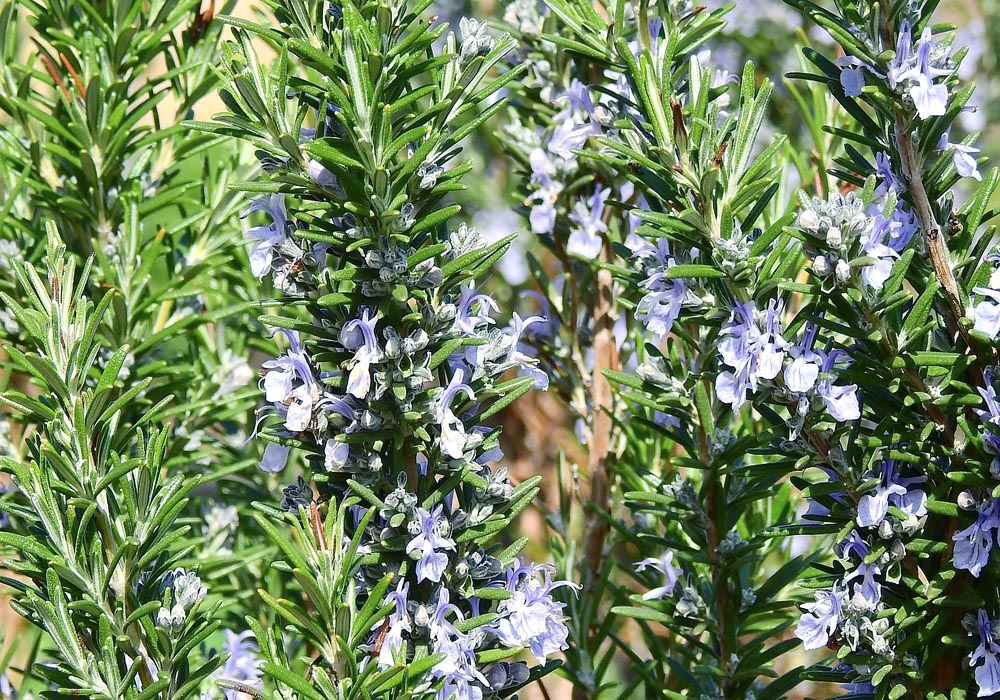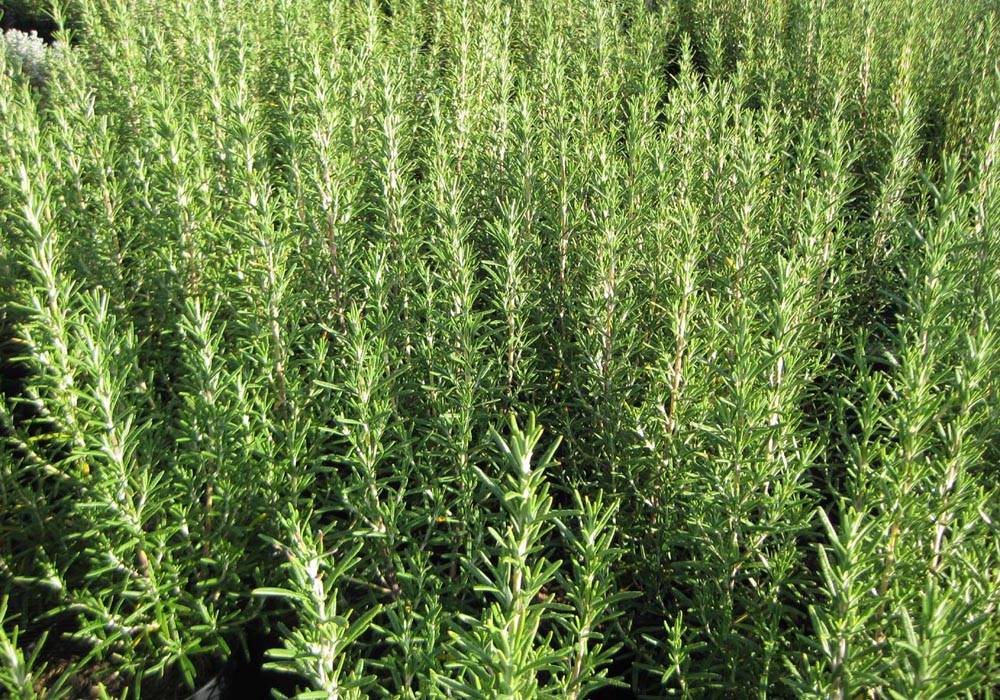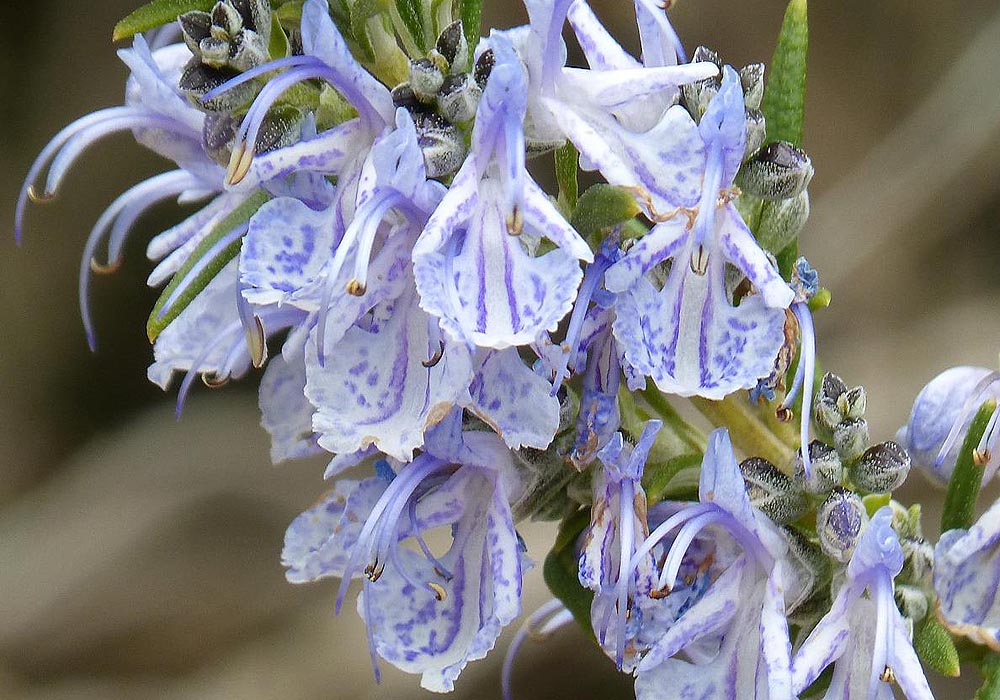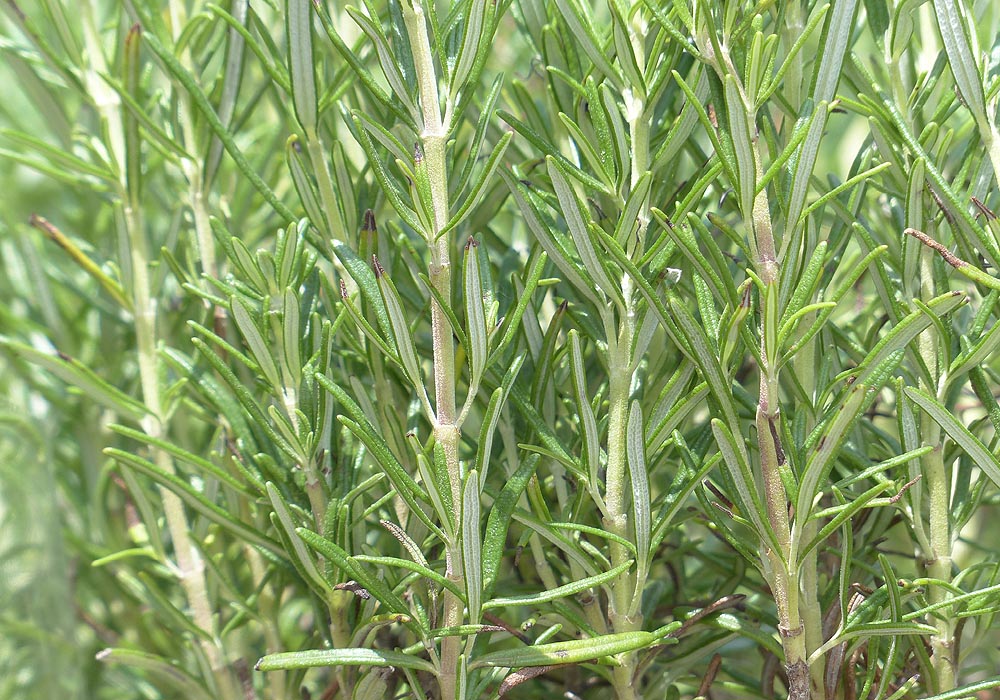A delightful drought resistant evergreen shrub for hot sunny dry locations. Hardy to zone 7b. Ideal for rock gardens and sandy soils as long as some shelter from winds is provided. Does not like a lot of water and requires a well drained semi dry soil. Cannot tolerate cold and will die if the roots freeze so needs to be grown as a container plant in zones 6 and higher. Makes excellent pot plant and idea for sunny deck or patio. Slow growing but needs very little care and attention once established. Foliage is highly aromatic and the flowers are loved by bees, butterflies and humming birds, while the foliage deters deer and rabbits. Can be trimmed into shapes and topiary easy to care for. Can overwinter pots in garage in colder zones.
Description of Rosemary (Rosmarinus officinalis).
A small erect evergreen shrub. Much branching with many upright stiff branches
covered with masses of thick, leathery linear, needle-like leaves to 1.5"
long ( 4 cm) that are lustrous dark green above and downy white beneath, depending
on growing location they can seem slightly blue or gray green. They have a prominent
vein in the middle which often appears like a white line and margins which are
rolled down. Leaves are borne in small clusters attached to the stems in opposite
pairs that alternate positions on the stem so the whole stem is covered in leaves.
Leaves are highly aromatic. Flowers are small lobed flowers with one larger
lobe below and four smaller ones above. They are normally lavender blue in color
but can be darker or even white with deeper colored mottling of spots and small
stripes. Flowers while small are often prolifically produced in auxiliary clusters
along the shoots of the prior year's growth and can cover the whole bush. Flowering
time varies depending on location from early spring to early summer, with flowering
being later in cooler zones.
Plants can grow to 5 feet in height (90 - 120cm) and spread to 3 feet (90 cm)
they can have a compact or sprawling habit depending on their location. The
flowers are extremely attractive to both butterflies and humming birds while
the aromatic foliage repels deer and rabbits. Also beloved by bees.
Growing Rosemary (Rosmarinus officinalis) from Seed.
Rosemary takes a little more work to grow from seed than other herbs. Rosemary
is also notorious for its low/poor germination so it is suggested that you plant
far more seeds that you want plants. Depending on how your seed was stored before
you purchased it, and how you stored it when you received it will often reflect
on how well it germinates. Our seed is stored under cool, controlled conditions
and we normally manage to obtain 50- 68% germination rates. Figures are usually
quoted at around 30% some even lower.
Since it does have germination issues it is highly recommended that you start your Rosemary inside in pots. Small pots or cell packs are the best option as it allow for removal of seedlings as they grow without disturbing seeds not yet germinated. See our general growing instructions for more information on this topic.
Sow in a light sterile potting soil, they are going to be in there for quite a while so you don't want weeds around them. Rosemary needs light to germinate so do not cover the seeds. Put them on the surface of the soil and then water in. If desired a very light coating can be sprinkled over with a sieve just to give the seeds more soil constant but not enough to cover them.
Keep the soil just moist at all times but not too wet. Keep them in a warm place, they wont germinate below 70°F (21 °C) and around 76 - 82°F (24 -27°C) is considered best. A sunny window or near a radiator that keeps a constant temperature is ideal. Some places recommend bottom heat but unless you are an experienced grower this is just going to dry your seeds out far too quickly so we don't recommend it.
Seedlings will start to germinate in about 14 days but can take up to 30 days, and remember, low germination rate, so expect anywhere from 30 - 50% to grow. We suggest keeping the seed tray around for a lot longer than the 30 days. Like lavender often seeds will germinate but it can take a LONG time to do so. Patience and a little TLC can coax more seeds to grow so don't give up too early and you should get more plants.
Seedlings grow very slowly so they need extra care. Once germinated, rosemary is highly prone to damping off, so keep watering to a minimum. (damping off is off is a fungus that cuts the seedlings off at the soil level so they die). So water only enough to keep the soil just moist, don't let it get wet. NEVER put rosemary in a tent or dome of any kind, this just encourages fungus and makes damping off an almost certainty.
Timing. Many places recommend that you sow 8-10 weeks before last frost date but since the seeds grow so slowly we don't really think it matters as they wont be ready to plant out then anyway.
Seedlings. Once a seedling is large enough to handle, transplant it
to its own pot (if not already grown that way). We suggest using a larger and
more sturdy pot that you would normally transplant into because Rosemary grows
very slowly so and the plants will be in them for quite a while. In most zones
it is not recommended that the plants be placed in the garden in the first year
because they grow so slowly that they are easily overtaken by weeds.
The large pots also allow for better water control. Small pots tend to dry out
very quickly and take more care and attention. A slightly larger pot will retain
water for longer. Place the pots in a sunny location somewhere you can keep
an eye on them during the year. A sunny patio, deck or somewhere near the house
is ideal. Check on them regularly, keep just moist, not wet but don't let them
get dust dry either.
Rosemary does not need a lot of water once its starts to grow and too much -
which would be just right for most other plants - can cause it to die off.
Location and Care of Rosemary (Rosmarinus officinalis).
Rosemary needs full sun. In higher zones (7-8) it will need a good sheltered
location that will capture more heat. For hotter zones it can be placed almost
anywhere that there is full sun as long as its not a very windy location.
Rosemary is very drought tolerant and does not like a lot of water at all. It
prefers soil that stays fairly dry and will not succeed in wetter or even constantly
moist soils. NEVER place rosemary near a house downspout the water runoff will
be too much and it will die.
Soil type. Rosemary prefers a well drained light soil, it is an excellent plant for rock gardens, rockeries and sandy locations. It prefers a slightly alkaline soil, on stronger alkaline and chalky soils it will not grow as large but it usually more fragrant. Rosemary is an excellent plant to have close to the house foundations as this area tends to be more alkaline due to the concrete and 'brick'. Choose a south of west facing side of the house well away from any downspouts. Make sure that your soil is light enough to drain well. Do not plant in clay soils, if your soil is hard and clay like either grow rosemary in pots or add a lot of compost to your soil increase drainage.
Spacing. Rosemary will grow to about 24-30" (60 -76 cm) wide so allow plenty of space around the plant. It is recommended that spacing be allowed for the plant to grow rather than planting more closely and then trying to transplant when it becomes larger. Choose other annual plants that will complement your rosemary and grow those near the Rosemary gradually cutting back as the bush gets larger. In good locations Rosemary can grow as large as 48" tall so don't plant near the front of the border.
Winter temperatures. Rosemary will die if its roots freeze so in zones
where it gets colder make sure that the plant is well mulched and planted in
a sheltered location. Often plants can survive in small microclimates near the
house if well protected. A deep mulching around the roots is essential.
Zone 6 and higher. More care needs to be taken. Unless you have a very sheltered
location Rosemary most likely wont survive a cold winter. In most cases in zone
6 and higher it is recommended that Rosemary be
planted in pots and brought
into the house or house attached garage for the winter months.
Container growing of Rosemary (Rosmarinus officinalis).
Rosemary is an ideal container plant. It can be trimmed into shape and even
used as topiary. Since it grows so slowly it keeps its shape for long periods.
It makes an excellent sunny deck or patio plant and does not need constant watering.
Place in more sheltered location if you live in an area where there is constant
heavy rainfall to ensure the pots don't get overwatered. Using ceramic or terra
cotta pots is recommended for Rosemary as it allows the plant to dry out faster
and not become overwatered. If using a glazed pot make sure it is not placed
in a location that will receive too much water. If a plastic pot is chosen make
sure that the drainage holes in the pots are large enough in size, often drainage
holes are not large enough to remove heavy downpours of water so plants that
don't like a lot of water. If necessary re-drill the holes to make them larger.
Fill the pots with a sandy soil even add a few small stones (there are always some in the garden that you don't want, now you have a use for them!). This is especially important if using a plastic pot because as the plant grows any wind can knock the pots over if they are not heavy enough to keep the shrub anchored.
Winter care of potted Rosemary.
Rosemary can be grown as a house plant at any time or it can just be overwintered
in the house if desired. In all cases place pots in sunny window location, south
facing is highly recommended, do not try and use north facing windows there
will not be enough light.
For overwintering pots placing the Rosemary pots in a garage that is attached
to the house is usually sufficient. Any structure that does not freeze in the
winter and has a window location for the plants can be used. Place pots in the
window offering as much light as possible and water a few times during the winter.
Don't let them dry out completely. The Bushes may suffer a little and die back
somewhat depending on what conditions you can give them but they should quickly
recover when returned to the outside the following spring, after danger of frost
has passed. Don't put them out too soon, and if there is a late frost bring
them in again.
Harvesting Rosemary (Rosmarinus officinalis).
Do not attempt to harvest from first year plants, they need to grow strong first.
Once plants have grown to a suitable size small branches and stems can be snipped
off as desired. Do not cut to much off one plant at a time. Since rosemary grows
fairly slowly it can take time for the plant to recover. Use a clean sharp knife
or floral snips. Never tear or rip the plant this can introduce disease.
Possible diseases and pests.
Susceptible to powdery mildew. Do not grow near lilacs, bee balm (Mondara species)
or anything else in your garden that is susceptible to powdery mildew. It can
also develop whitefly, scale and mealybug.
Companion Planting
Rosemary is a great companion plant to sage, cabbage, beans, carrots and thyme.
It repels or distracts the bean beetle, deters cabbage flies, and repels many
bean parasites. Do not plant near basil.
Culinary Uses of Rosemary (Rosmarinus officinalis).
Used as a flavoring. The leaves are very strong and aromatic so only small amounts
are needed. Most commonly used to flavour meats like lamb, but also in soups,
stews and vegetables like peas, cabbage and spinach. Another popular use if
for flavored vinegars and oils for salad use. Can be used in cakes, cookies,
jams jellies and desserts. The leaves are tough so need either to be finely
chopped, dried and ground or used as a bouquet garni. It can also be used in
teas but its strong
flavor is more of an acquired taste.
Medical uses of Rosemary (Rosmarinus officinalis).
Rosemary has long been used in medicine especially for the nervous system. It
is used as a tonic to help stimulate the brain especially in those that are
mildly depressed and/or mentally tired. Rosemary has properties that make it
effective in treating capillary fragility, this also encompasses other circulatory
maladies including mild heart conditions, palpitations and easing of sluggish
blood which can lead to headaches, decreased lung function and blood pressure.
An infusion of the leaves, or drops of the essential oil can be added to inhaled
steam to help treat headaches and nervous diseases. Recent studies have suggested
it has strong potential for treatment of toxic shock syndrome. It is also used
to treat colic, colds, loss of appetite and rheumatism. The whole plant has
strong antioxidant properties. It is also used externally in hair lotions where
it's properties as a circulatory stimulant help it to stimulate the hair follicles
to renewed activity and preventing premature baldness. It is often used in hair
washes and is a good remedy for scurf and dandruff.
Other uses
The pleasant aromatic essential oil is used in many cosmetics and shampoos.
The aroma is a strong insect repellent and is often used to repel moths from
clothing. The leaves can also be burnt and used either as incense, a fumigant
or disinfectant. Rosemary is also one of the ingredients used in the preparation
of Eau-de-Cologne.









